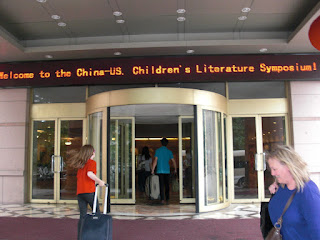Monday, June 11, 2012
Macro and Micro
The whole point of my trip to China, of course, was to attend the first-ever Chinese/American Children's Literature symposium, jointly sponsored by Texas A& M University and Ocean University, and held on the campus of Ocean University in Qingdao, China. Twenty invited delegates attended, ten from each country, as well as a wonderful, lively group of students from Ocean University who asked good questions during the Q & A after each session. Papers were submitted by April 1 so that they could be translated in a timely way, and a book-length compilation of all the papers together with their English or Chinese translation was given to each delegate. Each paper/talk was simultaneously translated as it was being presented, so we all sat wearing little headphones, as if we were at the UN. Each American visitor was also assigned a student helper to assist in everything we might need, particularly in translation, as all were fluent in English as well as being native speakers of Mandarin. Above, see our students beginning their duties by warmly welcoming us at the Qingdao train station.
It was hard not to be struck by the differences between the American papers and the Chinese papers, both in content and in style of presentation. The American papers were all "micro" in focus: examining one particular author, usually one particular text by one particular author, and often examining only one particular aspect of that particular text: "Embodied Metaphors in The Adventures of Huckleberry Finn," "Missionary Work and/as Children's Book Authorship in Elizabeth Foreman Lewis's Yung Fu of the Upper Yangtze (1932)," "Black and Beautiful and Bruised Like Me: The Black Aesthetic and Picture Books of Langston Hughes," "Representing Boys and Girls in the 1912 Book of Knowledge." My own paper was slightly broader, examining what I see as a trend in children's chapter books over the past few decades of books about spunky girls contrasted with books about wimpy boys. But I locate the origin of the trend in the books of one particular author, Beverly Cleary, and most of my paper focused on one particular scene in one particular book: the scene where Ramona Quimby gets the best of Henry Huggins-as-traffic-boy in Ramona the Pest.
The Chinese papers were all "macro" in focus: sweeping overviews of trends in Chinese children's literature over the past century, many of them highlighting the seminal contributions of Lu Xunhe, a thinker and writer in the May Fourth (1919) movement, whose book How To Be a Father Today turned children's literature in the direction of child-oriented rather than adult-oriented works. The papers also seemed more "directive" than the American papers, more prescriptive of what children's literature ought to be. I'm not sure how much this difference in approach has to do with some underlying cultural difference, or from the fact that the Chinese scholars were drawn more from colleges of education than from departments of literature, or even from some sense of responsibility on the part of the Chinese scholars to their foreign audience, who would need to get a sense of the broad terrain of Chinese children's literature before focusing on individual trees and rocks, let alone leafs and pebbles.
The two groups of scholars differed in style as well. Almost without exception, the American scholars read our papers verbatim, partly out of a desire to assist the translators, partly out of our own academic culture. Almost without exception, the Chinese scholars just stood before us and talked, often in an extremely lively and enthusiastic way, saying things that bore little perceivable resemblance to the text printed in the conference proceedings.
So: macro versus micro, sedate versus exuberant. But it isn't true that "never the twain shall meet," because they met most happily for two days in Qingdao, China, last week.
Subscribe to:
Post Comments (Atom)



No comments:
Post a Comment